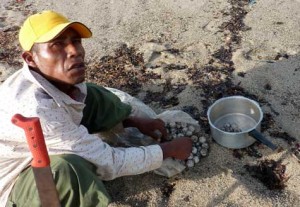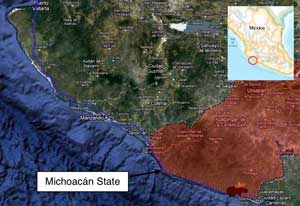Location: At Rio Nexpa, in the southern end of Michoacán, where muddy water from recent rainstorms dirties the turbulent ocean. Under coconut trees, palm thatch huts line the perimeter of the riverbank.
Conditions: The northerly breeze covers everything in salt spray. The air is pleasantly cool after the sporadic downpours.
Discussion: As I drove south, the landscape kept changing in surprising ways. Around Puerto Vallarta, the dense jungle and verdant coastal mountains rising out of Banderas Bay is like a perfect capsule of the tropics. It inspired Hollywood producers to shoot movies like John Huston’s The Night of the Iguana (which put the nonexistent Vallarta on the map), the pirate movie Swashbuckler, and Arnold Schwarzenegger’s Predator. Along the way, I asked about road conditions south and got various reports ranging from “OK” to “rough” to “dangerous.”
Past the bay, the coast morphs oddly into a dry tropical forest — it was just barely starting to show signs of green with the onset of the wet season. The Biosphere Reserve of Chamela (the link in Spanish can be found here) protects this unique forest, which is extremely productive by virtue of its seasonal leaf litter and diverse habitats.

In nearby Punta Perula, the talk of the town was the first rain of the season — when would it come? Further south, I visited a remote beach straddled by an abandoned resort, called El Tecuan, which had a wild look with its stormy waves and rugged rocky outcroppings. I camped next to some fishermen, who cooked clams over a fire. At night, flashlights shone from the hunters of sea turtle eggs. These searchers for illegal delicacies sell the tiny eggs for as low as 40 cents (U.S.) a dozen.
The rumors of banditos grew as I got closer to the state of Michoacán, which is poorer than its neighbors. I had heard of the notorious Bandito Alley from past travelers and books such as the travelogue In Search for Captain Zero, but I was ready to dismiss the entire notion. However, recent tales of kidnappings and road closures from locals and adventurous types that don’t usually fret made me hesitate.
I met up with an Argentine couple driving to South America, and we decided to caravan together into Michoacán.
It is easy to imagine an ambush in this area. The coastal plains give way to ominous mountains that squeeze you into a slow winding road over cliffs. Because of the inaccessible terrain and lack of development, the region has become a favorite for marijuana and poppy growers supported by the local drug cartel, “La Familia,” which is infamous for its displays of mind-numbing violence. Even as locals are suffering, common bandit activity such as theft on roadways has been (reportedly) suppressed by the drug cartels themselves, since it can raise unwanted attention. Hence, while the ambush of police officers and gunfights between cartels may occur, the old Bandito Alley tactics of barricading roadways with logs and stones to rob drivers may be a thing of the past.
However, another type of barricade still occurs. Armed guerrilla fighters allegedly connected with Zapatista forces blocked the only coastal route along Michoacán for a month and half, according to a local resident I spoke to. In charge were indigenous groups from La Ticla and neighboring areas that recruited the guerrilla group after quarreling with government officials over land rights to beaches — land that just happened to be on tourism giant Fonatur’s radar for mass tourist development.

Blockades are a typical means in Mexico for angry rural residents to express dissent and achieve a political end; it is somewhat tolerated by the authorities, who would rather let the public vent steam glowering behind some poles than risk a crackdown. Although I’m unsure of the resolution, the highway blockade did end peacefully. Nevertheless, it reflected the tensions in the area, where marginalized people are doing what they can to improve their conditions.
Other violent incidents have occurred recently in Bandito Alley, according to reports I heard. First, several campsites were attacked at night by men with knives, who took the campers’ belongings; as the story goes, the assailants were found murdered the next day, presumably by members of the drug cartel who want to discourage that type of behavior. The other report was of three Americans kidnapped by banditos dressed in military outfits, about six weeks prior to my visit. One hapless victim was sent to the ATM and store with a list of demands as the ransom; thankfully, the Mexican police busted the amateurish operation. Beyond those travelers’ tales and surfers’ folklore, a real background of drug violence involving, cops, cartels and politicians is charted daily by reputable news organizations. (See the news reports here and here.)

Although poverty-induced crime has many causes, in Mexico many rural residents still rely on farming for their livelihood; deteriorating land conditions have contributed to extreme poverty. The main causes of land deterioration include deforestation, which leads to soil loss, reduced water flow and quality, and the overuse of soil (i.e. not letting fields lay fallow long enough). Fickle precipitation patterns from a changing climate can only worsen the situation. A recent study suggests that immigration into the U.S. will increase as peasants encounter hardships due to climatic shifts.
If they don’t migrate to a better place, many people yield to crime, working for the drug cartels or independently. To paraphrase the most powerful drug dealer in Mexico (possibly the world), El Chapo, whose career lead him from destitution to become one of the world’s wealthiest men: The best way to stop drug cartels is by giving out food stamps. I may not agree with the efficacy of that idea, but it does suggest that desperate people are more likely to become criminals.
Mexico’s troubles are nothing new. Rural poverty catalyzed by soil degradation has been a fact of life since agriculture was first practiced in Mesopotamia. The disruption of the social fabric by drug trafficking has occurred back to at least the times of China’s Opium Wars. It is now Mexico’s turn to walk the tight rope, teetering between a rapidly deteriorating environment that is crushing farmers and a drug war that accelerates that same destruction, as discussed in my previous post. Meanwhile, the stakes are getting higher in a climate (economic and atmospheric) that is increasingly challenging.
Whether they will be able to resolve those issues as some past societies have is a topic for the next post. Meanwhile, just because Bandito Alley is now (somewhat) safer for travel does not mean that the overall stability of the region, especially for local people, is improving. It is as if their future is chronically barricaded — and we need new tools to end it.





